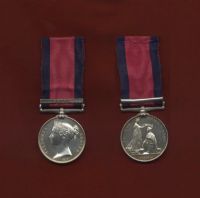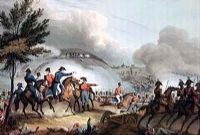Stephen Clifford
Date published: 01/10/2018
© Wikipedia
|

The Military General Service Medal
©FNRC
The Military General Service Medal
|

The 12th Dragoons in action
©The Regimental History
The 12th Dragoons in action
|

"Battle of Salamanca, etched by J. Clarke, coloured by M. Dubourg."
©Wikipedia
"Battle of Salamanca, etched by J. Clarke, coloured by M. Dubourg."
|
STEPHEN CLIFFORD
According to the Peninsular Medal Roll, he was entitled to wear this medal with clasps for “Egypt” and “Salamanca”.
[Note: The Military General Service Medal (MGSM) was authorized by a General Order dated 1st June, 1847 and issued in 1848.
This was a campaign medal for issue to officers and men of the British Army and sometimes it was referred to as the Peninsular Medal.
It covers military actions from 1793-1814.]
The accompanying picture is an example of this medal (but without the Salamanca Clasp)l:-
In 1751 the Regiment was officially styled the 12th Dragoons. In 1768 King George III bestowed the title of the 12th (Prince of Wales) Regiment of (Light) Dragoons, the Regiment was given the badge of the three ostrich feathers, and the motto “Ich Dien”
The 12th Dragoons, led by Sir John Doyle won their first battle honour inEgypt in 1801 against the French Dromedary corps. They had previously had a young Duke of Wellington serve with them as a subaltern between1789 – 91.
In 1816, the 12th Light Dragoons were armed with lances after the cavalry of Napoleon’s Army had shown their effectiveness at Waterloo and were re-titled 12th (Prince of Wales’s) Regiment of (Light) Dragoons (Lancers)
In the Battle of Salamanca (in French and Spanish known as "Battle of Arapiles") an Anglo-Portuguese army under the Duke of Wellington defeated Marshal Auguste Marmont's French forces among the hills around Arapiles, south of Salamanca, Spain on 22 July 1812 during the Peninsular War.
Sources:as above |
|
|
|

